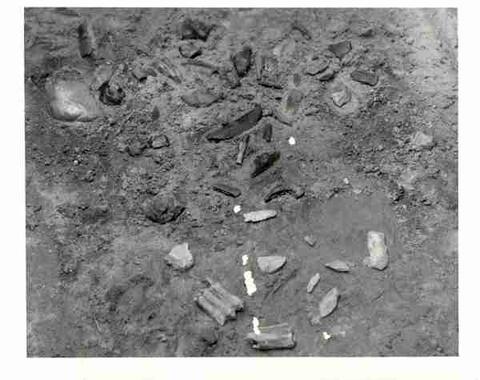
Title and statement of responsibility area
Title proper
Mortlach archaeological site
General material designation
- Graphic material
Parallel title
Other title information
Title statements of responsibility
Title notes
Level of description
Item
Reference code
Edition area
Edition statement
Edition statement of responsibility
Class of material specific details area
Statement of scale (cartographic)
Statement of projection (cartographic)
Statement of coordinates (cartographic)
Statement of scale (architectural)
Issuing jurisdiction and denomination (philatelic)
Dates of creation area
Date(s)
Physical description area
Physical description
1 photograph : b&w ; 10.2 cm x 7.6 cm
1 negative : b&w
Publisher's series area
Title proper of publisher's series
Parallel titles of publisher's series
Other title information of publisher's series
Statement of responsibility relating to publisher's series
Numbering within publisher's series
Note on publisher's series
Archival description area
Name of creator
Administrative history
On April 2, 1889, J. N. McDonald began publishing a weekly newspaper entitled the Moose Jaw Times. In 1904, the paper changed from a weekly paper to a semi-weekly paper. After the discontinuation of the Times Morning Herald during the 1920s, the paper became the Moose Jaw Times Herald. The newspaper changed hands many times – shortly after its first publication it was sold to Hamilton Lang, in 1894 it was sold to Walter Scott, in 1945 it was sold to J. E Slaight and then to Roy Thomas, in 1995 it was sold to Hollinger Newspapers, then to CanWest in 2000, and finally in 2002 to the Transcontinental Media Group.
Custodial history
Scope and content
Floor excavation showing pavement of bone and artifacts at the Mortlach archeological dig site
Notes area
Physical condition
Immediate source of acquisition
Arrangement
Language of material
Script of material
Location of originals
Availability of other formats
Restrictions on access
Terms governing use, reproduction, and publication
Contact the Moose Jaw Public Library Archives Department for information regarding reproductions and/or copyright issues.
Finding aids
Generated finding aid
Associated materials
Accruals
General note
The first archaeological "dig" in Saskatchewan was undertaken in 1954 in the Besant Valley, 5 km east of Mortlach, by Provincial archaeologist Boyd Wettlaufer. The Mortlach site, as it became known, was a stratified site with distinct layers which would play an important role in establishing a framework for archaeology not only in Saskatchewan, but across the Great Plains.
The site is located on the south side of Sandy Creek, a small spring-fed stream which has its origins near the base of high bluffs south of Mortlach. It meanders through the Besant Valley, on its way to join Thunder Creek near Caron, SK. It eventually empties into the Moose Jaw River.
After M. McLean of Mortlach found arrowheads on a cow path at Besant, enthusiastic amateur diggers and artifact collectors moved in, destroying much of the valuable archaeological evidence. When the provincial archaeologist and his crew arrived on the scene they were hard-pressed to find a piece of undisturbed ground.
Wettlaufer found eight clearly defined levels of occupation which he called "cultures". He wrote: "Culture would be defined as a complex of tools (stone and bone artifacts) sufficiently different from the cultural complex above and beneath it to be considered the work of a different people." He named these cultural levels after nearby place-names e.g. the Mortlach Culture, the Moose Jaw Culture, etc.
The top or latest layer, called the Mortlach Culture, dated from 1780 to the time when the last buffalo inhabited the area. It was located near a Bison kill-site where great quantities of bones and masses of bison hair, preserved for a century in the sandy soil, had been dug out by the amateurs. Below the Mortlach Culture, Wettlaufer found another layer of occupation which he called the Moose Jaw Culture because he was certain, from observing materials in private collections and from his own explorations along the Moose Jaw River, that the centre of this culture was in the vicinity of Moose Jaw. The excavation revealed fire hearths and among fragments of pottery was a pot rim clearly showing thumb and finger impressions that resembled the finished edges of our current pie crusts. One blue trade bead and a metal scraper made by flattening a small piece of a gun barrel, indicate that the Moose Jaw Culture, dating from 1700 had contact with Europeans.
The next layer of occupation belonged to the Caron Culture dating from 1600. These prehistoric hunters fashioned their points and blades from brown chalcedony or Knife River flint from a quarry in North Dakota. This indicates that they had access to the resources of other areas. The Besant Culture, whose periodic occupancy spanned nearly a thousand years from around 34 A.D., was one of the main cultures of the Mortlach site. These people with their darts and corral-building knowledge were masters of the pound-hunting technique. At Besant they left behind evidence of a post-in-ground dwelling, the first "house" of this kind to be found in Saskatchewan. Nomads who followed the migratory bison were not known to construct stationary shelters but resorted to the hide-covered conical teepee which could be moved from camp site to camp site.
There were more cultures: The Sandy Creek people around 445 B.C. and the Pelican Lake Culture at 800 B.C., before archaeologists reached the earliest cultural level at the site i.e. the Thunder Creek Culture which rests upon the clay of the valley floor. Carbon dating gave an age of about 3400 years, which places the finds in the 14th century B.C. An historian pointed out: "In the east the Phoenician alphabet had just been invented; King Agamemnon was beginning the siege of Troy; and sometime later Moses would lead the Israelites out of Egypt."
The above article appears courtesy of Leith Knight, published in the Moose Jaw Times-Herald, February 1st, 2002.
see also: http://www.historicplaces.ca/en/rep-reg/place-lieu.aspx?id=16231
Location note
Folder 68-11 to 68-20

